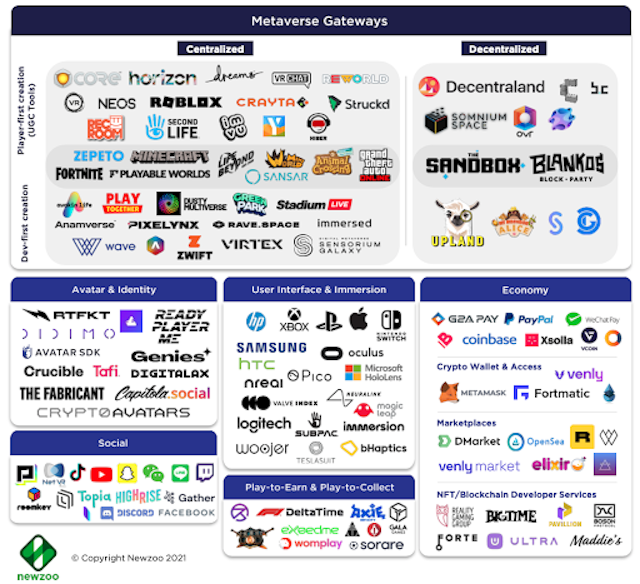How advertisers can navigate the metaverse
Last week, Facebook debuted Ray-Ban Stories, the first-generation Facebook smart glasses created in partnership with Ray-Ban parent company EssilorLuxotticca, which allows wearers to capture photos and videos, take phone calls and listen to music. The release of Ray-Ban Stories was met with mixed reviews as analysts noted the privacy and security concerns that would accompany some of the impressive features within the modest product design and previous smart glasses competitors. Nevertheless, Facebook’s entrance into the wearables market with Ray-Ban Stories signals an important step in the company’s larger business transformation, as Facebook seeks to bridge the divide between the physical hardware and digital social apps to become a ‘metaverse’ company.

PMG on what a fully-envisioned metaverse will look like and what can be done now to start preparing for it
While the term ‘metaverse’ first appeared in science fiction nearly thirty years ago, the underlying construct of an ‘expansive network of persistent, real-time rendered 3D worlds and shared simulations that support continuity of identity and objects’ is being actualized through popular tech companies and platforms such as Alphabet, Decentraland, Fortnite and Roblox. Advances across augmented and virtual reality, digital goods, fashion, wearable technology and virtual experiences are positioning the metaverse as the successor to the mobile internet and an extension of ‘what comes next’ for human creativity.
“The metaverse will not fundamentally replace the internet, but instead build upon it and iteratively transform it.” – Matthew Ball, advisor and venture capitalist at EpyllionCo
Market analysis: the virtual universe
To best understand how the metaverse is taking shape (and will continue to evolve), marketers need to look no further than the behavior and habits of gen Z and gen alpha during the pandemic. As public safety measures and regional lockdowns curbed in-person activities, younger generations spent more time in-game and across digital environments than ever before, as gaming has become synonymous with socializing. While older millennials spend downtime scrolling through social feeds, gen Z and gen alpha are logging in to explore virtual worlds, connect with friends and attend experiences in digital environments.
Global Web Index reports that gaming remains the top interest of kids aged eight to 15, with over 70% of boys and 64% of girls saying they play video games most days or every day.
Interestingly, regional lockdowns and more time spent at home allowed more family members to pick up controllers and try their hand at gaming, resulting in the rapid normalization of gaming for the young and old alike. Gaming hardware, such as the Nintendo Switch, sold out nationwide, and games including Among Us, Animal Crossing: New Horizons and Fall Guys: Ultimate Knockout notched record-breaking numbers of players and online viewers. During 2020, Twitch viewership grew 120% year-on-year, as analysts predict esports audiences could surpass 577 million by 2024.
While in-game environments are the current landscape for early metaverse activations, it’s important to note that brand collaboration opportunities can take many forms across dozens of technology platforms. In a recent report, Newzoo provided a snapshot of just how complex the growing metaverse landscape has become as the concept blends avatars and user identity, social community, digital economies and payments, immersive experiences and user interfaces with centralized portals into these constructed environments.

As the virtual and physical worlds continue to converge into the metaverse across an ecosystem of platforms, brands have a unique opportunity to engage with new and loyal customers in these emerging spaces, capitalizing on consumer behavior and market trends that are fueling the digitization of culture and the future of the internet.
Strategic recommendations: prepare for the metaverse
While mass adoption of a fully envisioned metaverse has yet to come, there’s plenty that can be done now to start preparing for its eventual arrival. By understanding and demystifying some of the building blocks of the metaverse, brands of all sizes, and across all industries, can begin to explore what qualities and experiences will shape the intersection of our physical and virtual worlds.
Explore non-fungible tokens (NFTs) – NFTs offer the easiest entry point into the metaverse. Buying, collecting and selling items via the blockchain establishes NFTs as a powerful way to create brand love and encourage collaboration in the metaverse. Think of NFTs as collaborative collectibles for your brand. NFTs have one owner (or fractional ownership), with that ownership fully tracked via the blockchain. For the luxury and high-cost categories, NFTs also create a unique opportunity to provide more approachable options for consumers who may not be ready for a physical world purchase or as digital companions to physical world purchases. As ownership transfers, sometimes at increasing values, NFTs also allow for the original creator, and even previous sellers, to still receive a percentage of profits, making it more equitable for all.
Dive deeper into blockchain – Once you have a handle on how the blockchain facilitates NFTs, it’s worth exploring what it can do to drive business. One of the most common applications of the blockchain is smart contracts, which have a massive upside for media plans and influencer/creator partnerships. With ad fraud predicted to cost around $42bn for advertisers, blockchain technology can also be applied to manage and reduce click fraud, allowing marketers to better manage spend on working media.
Plan for decentralized finance – As your brand begins to blend physical and virtual worlds, marketers will need to consider the expanding role of cryptocurrency. There are plenty of biases around cryptocurrency (namely its volatility), but the reality is that it will be the monetary system of the metaverse. Cryptocurrency will likely be the primary method of payment in the metaverse for media placements, creator partnerships and the purchasing of goods and assets. As the metaverse blends our physical and virtual worlds, it’s entirely reasonable that crypto will become as common a payment option for online and in-store purchases as credit is.
Invest for the long game – As marketers, it’s sometimes difficult to take a big step without a promise of profitability, but brands that plan for the long-term will see much higher returns from the metaverse compared to brands that immediately try to hop in and monetize. BMW recently introduced Joytopia, which will eventually become its home for digital events. For now, however, it’s a place to test, host one-off moments (such as a Coldplay concert) and gather feedback from users on what they’d like to experience in the future.
Dig in and have fun – Whether it’s building something new, joining something popular or signing up for a Discord server to learn more from other metaverse enthusiasts, you can’t get a handle on what the metaverse can do by sitting on the sidelines. Look for ways as an individual and a brand to build, learn, fail and improve.
The metaverse won’t be built in a day, but that doesn’t mean you can or should wait.
Joe Flowers, content strategy at PMG, with editorial input from Abby Long, communications strategist and managing editor.
Content by The Drum Network member:

PMG
PMG is a global independent marketing services and technology company that seeks to inspire people and brands that anything is possible. Driven by shared success,...
Find out more
